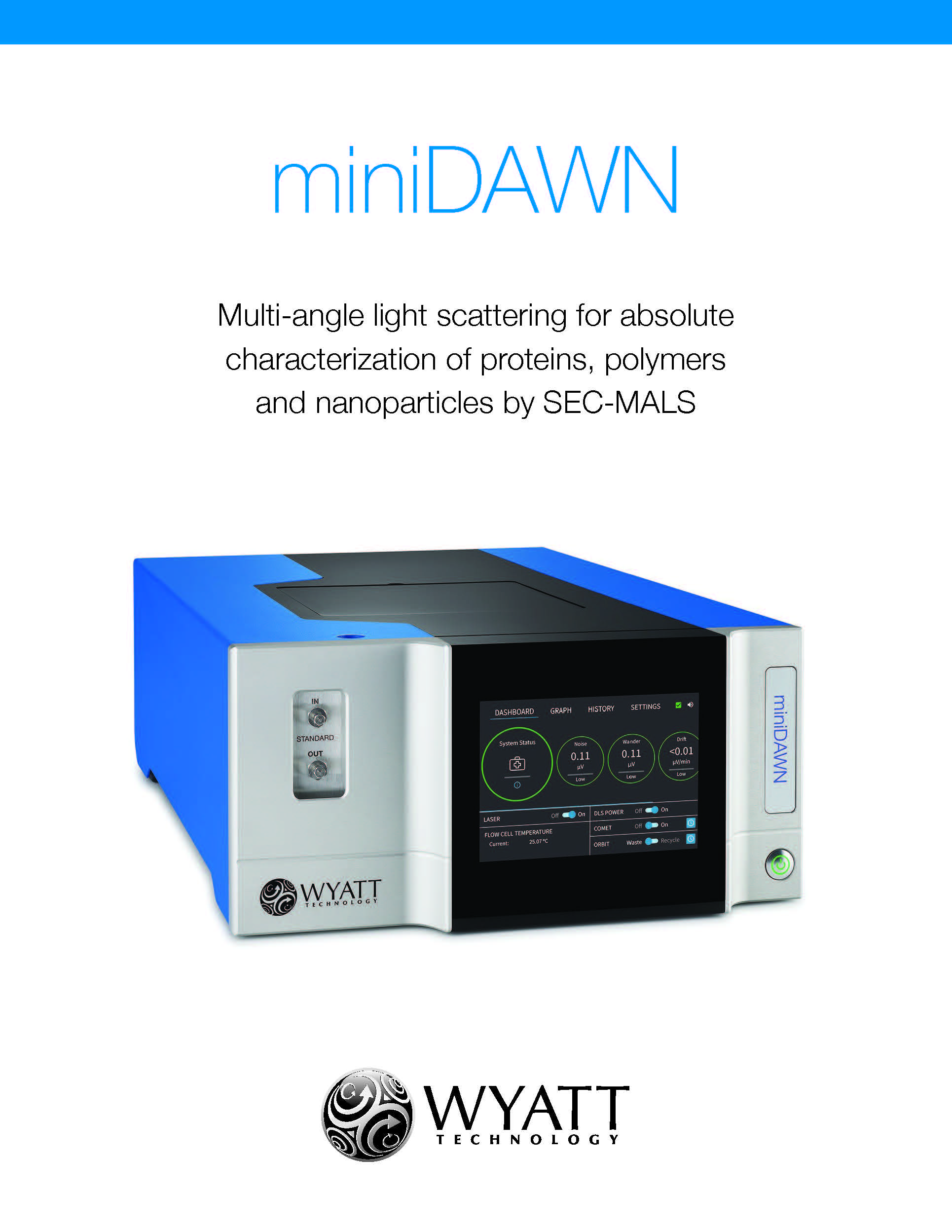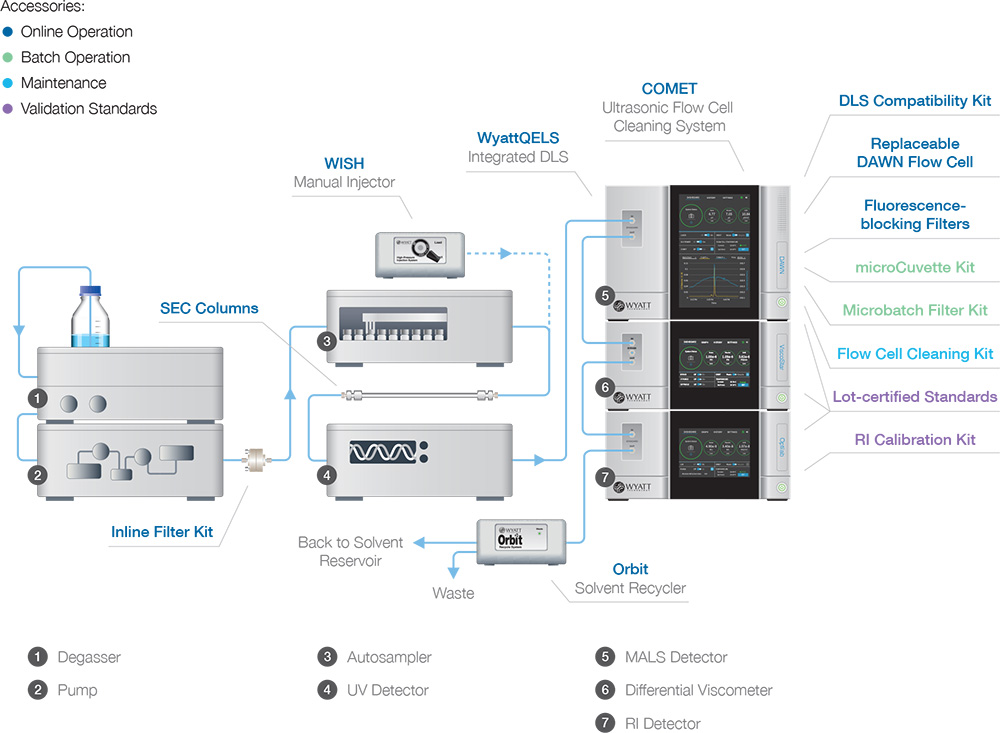miniDAWN
Product Overview
Product Description
Brochure
Options
On-Line Operation
Batch Operation
Accessories
Software
Specifications
Testimonials
Other MALS Instruments
Publications
Request Info
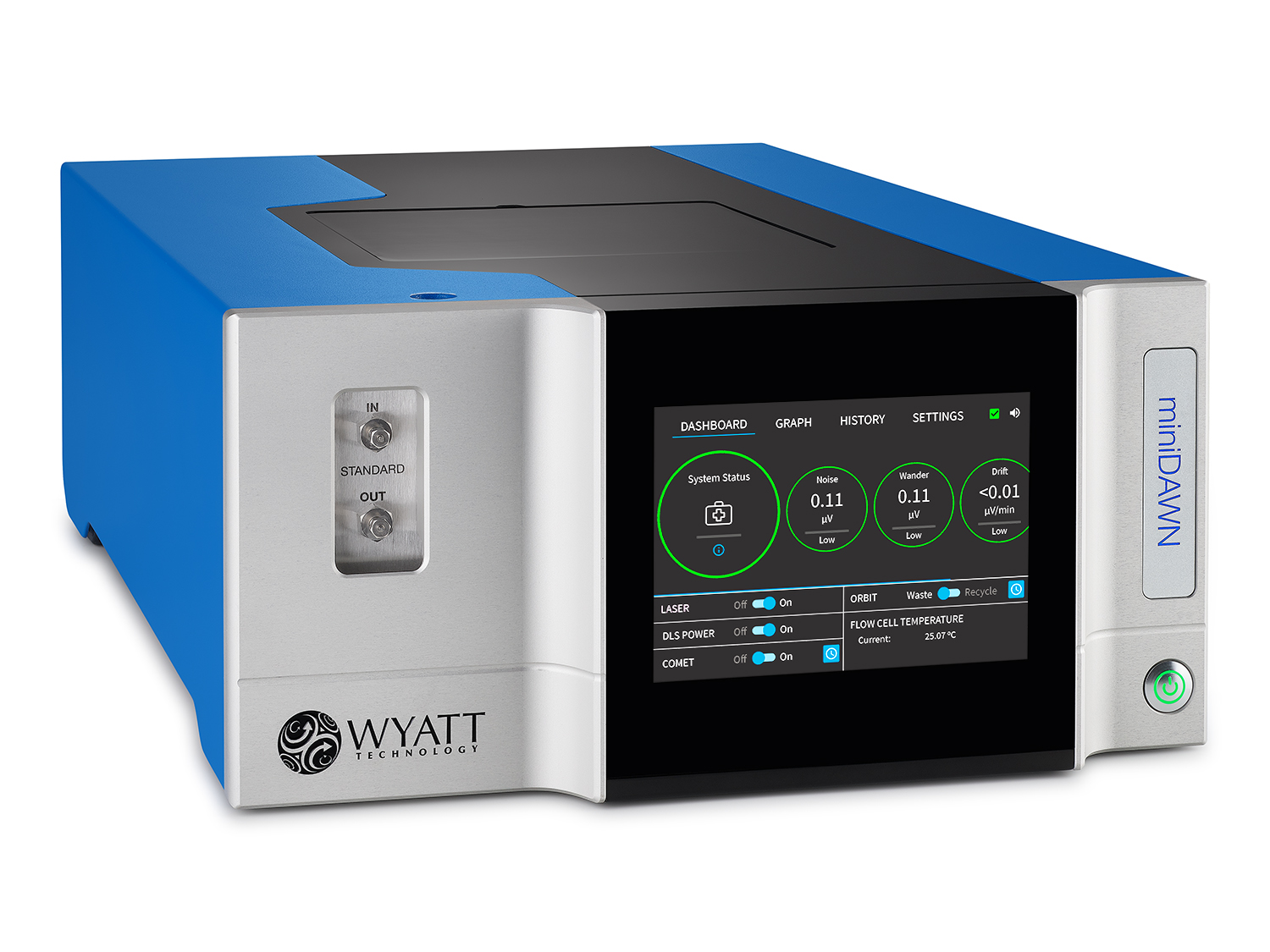
The Best in Basic Multi-Angle Light Scattering for Absolute Macromolecular Analysis.
Molar Mass
The miniDAWN™ determines absolute molar mass and size to characterize proteins, peptides, small polymers and nanoparticles in solution. Coupled to size exclusion chromatography (SEC or GPC), it eliminates the uncertainty and hassle of column calibration, for true confidence in macromolecular characterization.
Superb Sensitivity
The miniDAWN not only offers superb sensitivity—it further enhances productivity thanks to greatly enhanced field serviceability and easy data analysis with One-Click Mw™.
Compatible with ASTRA™
The miniDAWN is accompanied by ASTRA™, the most versatile software package available for analysis of online multi-angle and dynamic light scattering. ASTRA and the miniDAWN incorporate advanced ease-of-use features that help guarantee excellent measurements with a single click.
Molar mass, absolutely
Wyatt's miniDAWN is most often used in conjunction with size exclusion chromatography (SEC-MALS) or field-flow fractionation (FFF-MALS) to determine distributions of molecular weight, size and composition. No need to make assumptions about molecular conformation or ideal column interactions.
Characterize:
- Proteins, small peptides and oligonucleotides
- Synthetic and natural polymers
- Nanoparticles, virus-like particles and vesicles
Measurement Range:
- MW from 200 Da to 10 MDa
- rg from 10 to 50 nm, up to 150 nm with shape-specific models
- sensitivity down to 25 ng of 100 kDa polystyrene in THF, injected on a standard GPC column
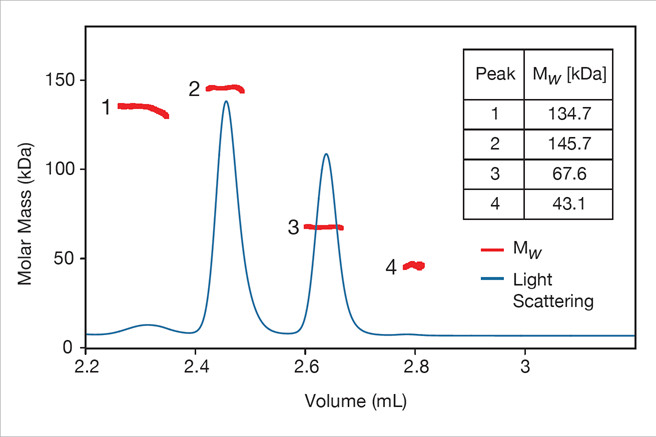
The miniDAWN determines molecular weight independently of column calibration. Here MALS shows that the earliest-eluting molecule does not have the highest molar mass.
The miniDAWN's performance is exceeded only by the DAWN™ which covers a wider range of size and molecular weight, with even better sensitivity and additional optional modules.
Ultrasonic Cleaning Included
Each miniDAWN includes an embedded COMET™ ultrasonic transducer that cleans the flow cell automatically by agitating the fluid and loosening particles from the glass surfaces.
Modularity = Productivity
The miniDAWN incorporates a fully modular design. Each module can be tested independently by the software to verify that it is functioning correctly. This imparts nearly complete field serviceability, since malfunctioning modules can be replaced and validated on-site by service engineers with no further calibration or alignment.
The miniDAWN is also field-upgradeable: the embedded WyattQELS™ DLS Module for measuring hydrodynamic radii from 0.5 to 50 nm can be installed on-site as well as in new units shipped from the factory.
Not just SEC-MALS...
Wyatt's miniDAWN may be used in batch (off-line) mode or in conjunction with a Calypso™ CG-MALS system for characterization of average solution properties as well as macromolecular interaction properties including protein-protein binding affinity and complex stoichiometry.
Simplicity personified
With miniDAWN and ASTRA, SEC-MALS became a whole lot easier. Sample-specific methods are set up in three short steps with ASTRA's Method Wizard, and new capabilities for automatic data processing mean that it takes just one click from your sample to a full report of the molecular weight and size results.
The miniDAWN's System Ready monitor will even let you know when the system is fully equilibrated with low baseline noise, ready to run.

Multi-angle light scattering for absolute characterization of proteins, polymers and nanoparticles SEC-MALS
Click here to request a copy of our miniDAWN brochure.
Dynamic Light Scattering
WyattQELS™ - A dynamic light scattering (DLS) detection module which integrates inside the miniDAWN chassis to provide simultaneous DLS measurements in the same scattering volume. The optical collection fiber is held in a dedicated 135° fiber mount.
Alternatively, connect an external DLS instrument via fiber optic cable - both the DynaPro™ NanoStar™ and DynaPro™ ZetaStar™ can do double duty as batch and online DLS instruments. Since they collect light directly from the MALS flow cell, the mass/size correlation is still dispersionless.
Basic On-line Configuration
The miniDAWN may be positioned downstream of all types of standard GPC, HPLC or FPLC systems for analysis of molar mass and size distributions (see SEC-MALS page), and derivatives such as conformational analysis. For those systems equipped with a UV, RI, fluorescence or other type of concentration detector, the miniDAWN accepts 2 analog inputs so a 3rd-party concentration signal may be used in MALS calculations of molar mass. The miniDAWN instrument is generally set up downstream of a UV detector and upstream of a RI detector.
In most cases it is beneficial to connect an Optilab™ as well as a UV detector. This permits universal concentration detection regardless of fluorophores or chromaphores. The combination of UV and RI signals is utilized in ASTRA's Conjugation Analysis algorithm to characterize binary complexes such as glycoproteins, PEGylated proteins, membrane proteins enveloped in surfactant, or block co-polymers.
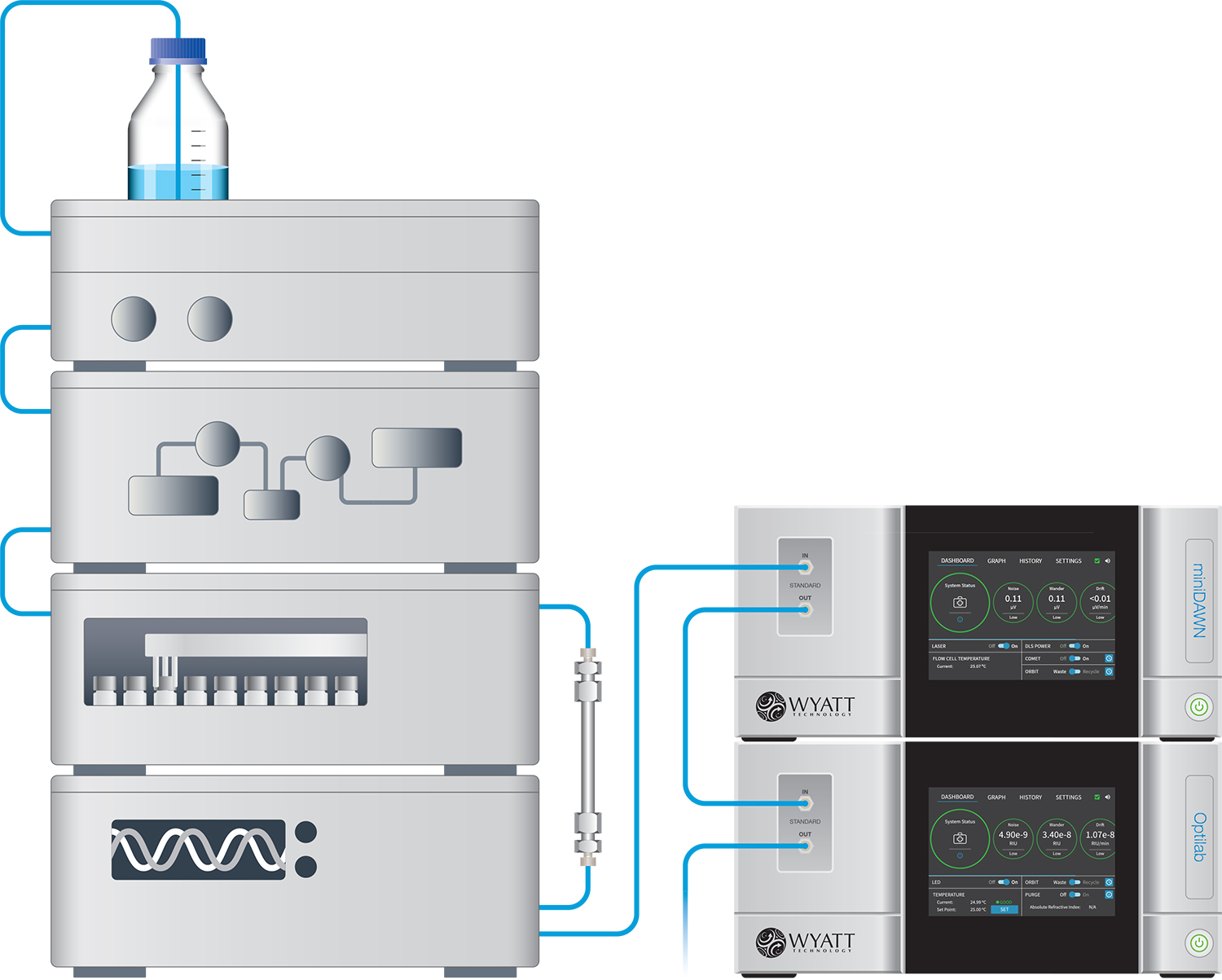
Advanced On-line Configurations
Wyatt's miniDAWN may also be connected to an Eclipse™ Field-Flow Fractionation system for characterization of macromolecules and nanoparticles from 1 nm to > 100 nm via FFF-MALS.
Both SEC-MALS and FFF-MALS will benefit from an additional WyattQELS™ module for measuring nanoparticle size via dynamic light scattering. The WyattQELS utilizes the same laser and flow cell volume as MALS detection. Its collection fiber, placed at 135° to the laser beam, does not displace any of the three detectors in the miniDAWN.
For analysis of natural and synthetic polymers, a ViscoStar™ online viscometer may also be added as well. Differential viscometry is an orthogonal means of determining molar mass and conformation.
MALS detectors may be operated in batch (unfractionated) mode when the analysis is targeted at:
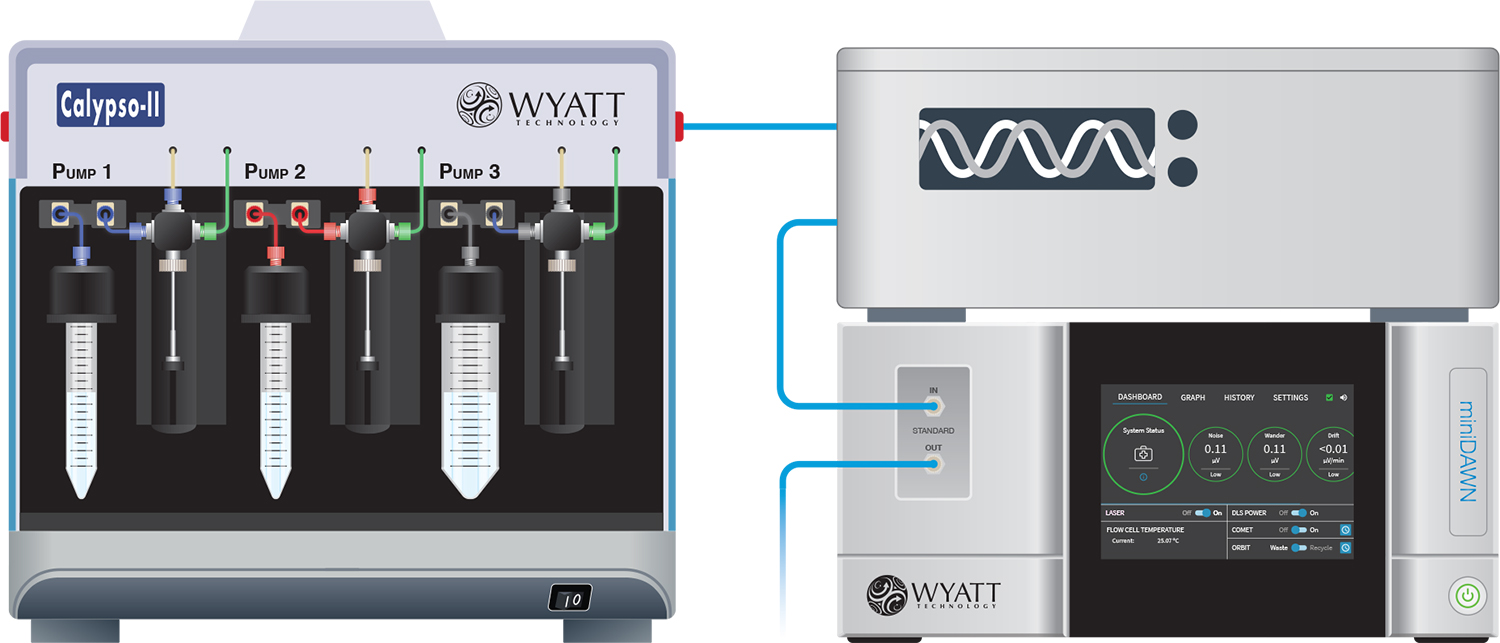
Macromolecular interactions
- In order to characterize macromolecular or nanoparticle complexes which are disrupted by column shear or dilution
- In order to measure binding affinity or reaction kinetics of macromolecules such as protein-ligand interactions
Average solution properties
- If the sample is not amenable to separation by SEC or FFF, to measure weight-average molar mass, and size as z-average radius
- In order to validate SEC-MALS measurements:
- to determine if large aggregates or other species are filtered out on the column
- to determine if reversible aggregates dissociate subsequent to dilution on the column or FFF separation channel
Calypso™ - Automated sample preparation and delivery system for carrying out and analyzing composition-gradient MALS in a miniDAWN. Analyses include biomolecular interactions analyses high-concentration protein-protein interactions, Zimm plots and dn/dc as well as time-resolved MALS. Utilizes the CALYPSO software for interaction analysis.
Microbatch Kit - Used to inject samples into the flow cell of a MALS detector, and in determining dn/dc with an RI detector.
ASTRA™ - Our comprehensive software solution for MALS and DLS analysis in chromatography, field flow fractionation or batch mode.
ASTRA offers a suite of basic and advanced analyses, including customized reports and an optional 21 CFR Part 11 compliant security and database package.
Optional HPLC CONNECT software provides integrated control of your HPLC stack with full digital synchronization between your HPLC system and Wyatt detectors – all within ASTRA.
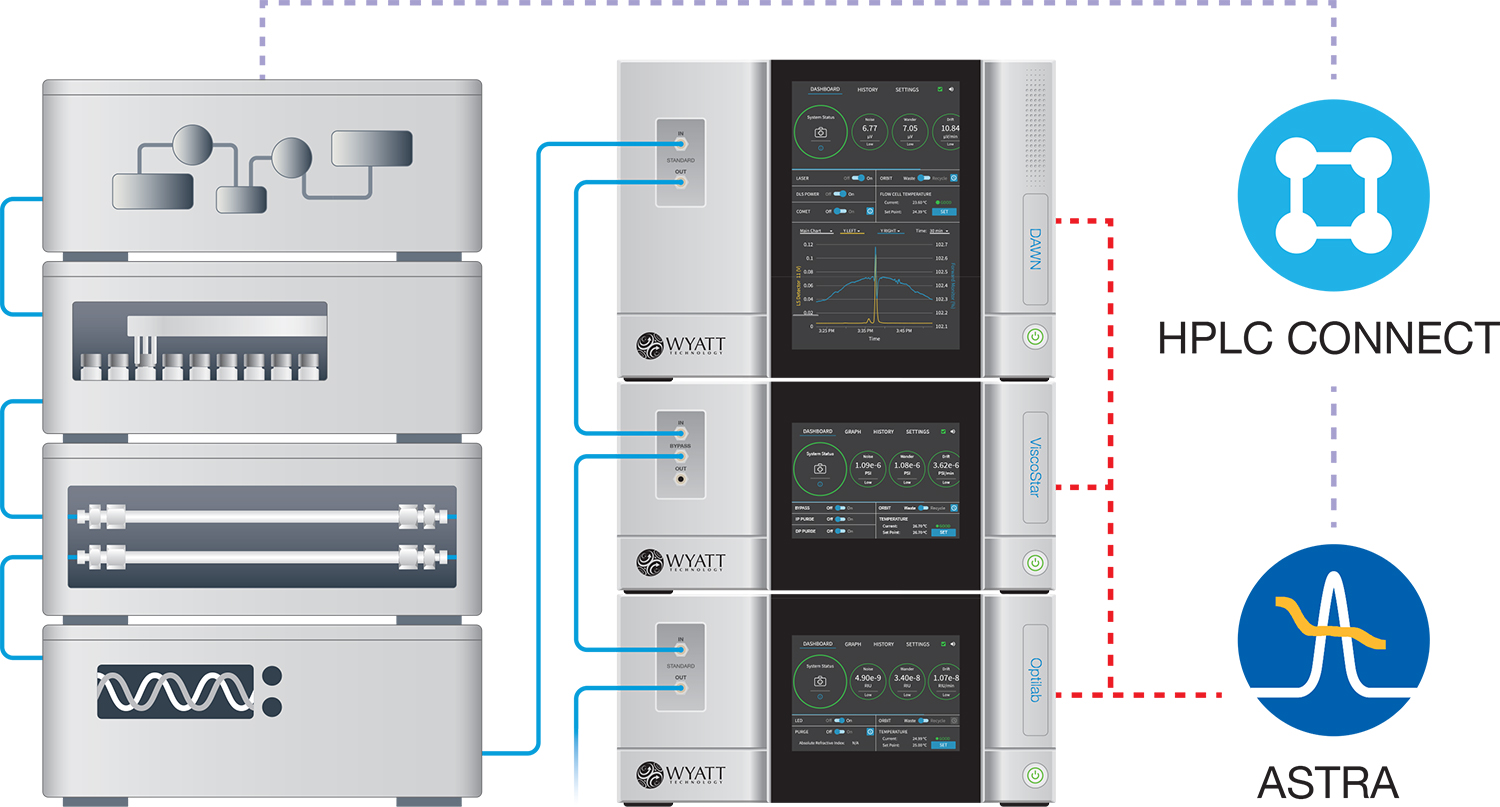
ASTRA's Method Builder simplifies the specification of methods for the most common analyses, in three intuitive steps:
- Choose your scientific application
- Specify the instruments
- Enter sample and run parameters
Maximize your productivity via ASTRA's One-Click MW feature, automated multi-sequence processing and HPLC/UHPLC integration. ASTRA will:
- Synchronize data collection with your HPLC or UHPLC
- Autoprocess data to determine MW and radius
- Generate custom reports and graphs
- Prepare for the next run
| Measurements | |
| Molar Mass Range | 200 Da to 10 MDa (proteins) or 1 MDa (linear polymers)1 |
| Molecular Size Range (Rg) | ≈ 10 nm to 50 nm, up to 150 nm with shape-specific models |
| Molecular Size Range (Rh) | In flow mode, 0.5 nm to 50 nm2; batch mode 0.5 nm to 1 μm (requires WyattQELS DLS module or DynaPro® NanoStar® + fiber optic connection) |
| Sensitivity | 25 ng of 100 kDa polystyrene in THF or 500 ng of BSA in PBS, assuming standard 7.8 mm x 300 mm SEC column and no post-column filter |
| Fluidics | |
| Mobile Phase Compatibility | All-solvent compatible (aqueous and organic); Wetted materials are 316 stainless steel, fused silica, and Kalrez |
| Optics | |
| Detectors | |
| MALS Detectors | High-gain, high dynamic range photodiodes at 3 detection angles |
| Auxiliary Detectors | Laser monitor for stabilization feedback; forward transmission monitor to correct signals for absorbing samples and to assess data quality |
| Dynamic Range | 3,300,000:1 |
| DLS Detector (optional) | WyattQELS dynamic light scattering module installs directly inside the miniDAWN chassis. Alternatively, the optical fiber pickup of the DynaPro NanoStar cuvette-based DLS instrument or Mobius DLS-ELS instrument may be installed in the miniDAWN. |
| Laser Properties | |
| Laser Wavelength | 658 nm ± 4 nm |
| Laser Power Control | Programmable 10% to 100% |
| Sample Temperature Control | Ambient |
| Electronics | |
| Analog Inputs | 2 differential analog inputs with 24 bit resolution; Input range -10 V to +10 V |
| Analog Outputs | 1 analog output from user selectable measurements channels -10 V to +10 V |
| Other Inputs/Outputs | Alarm in, Alarm out/retransmit, Auto-inject in, Auto inject contact closure retransmit, Recycle In/Out (operates Orbit™ recycle valve) |
| Computer Interface | Ethernet |
| Processed Data Rate | Up to 36.6 Hz |
| Front Panel Display | 7" (178 mm), high-resolution, multi-touch display for viewing/setting signals, instrument settings and diagnostics |
| Dimensions | 58 cm (L) x 36 cm (W) x 18 cm (H) |
2Upper limit assumes a flow rate of 0.3 mL/min or less.
Host PC requirements may be found in Computer Requirements.
Specifications subject to change without notice.
Other MALS Instruments
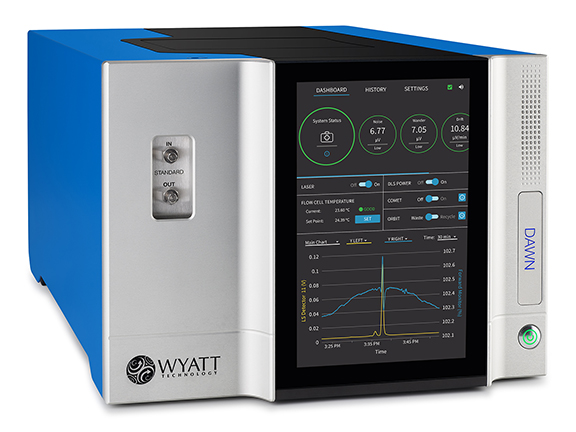
DAWN™ - The most sensitive MALS detector available, anywhere. Incorporates detectors at 18 angles to determine molar masses from 200 Da to 1 GDa and radii from 10 – 500 nm.
- Standard option: ambient temperature
- Heated/cooled option: -15 °C to +150 °C
- High-temperature option: ambient to +210 °C
The DAWN offers special options to handle fluorescent samples: fluorescence-blocking filters and an infrared, 785 nm laser.
microDAWN™ - The first MALS detector for UHPLC, with interdetector dispersion as low as 1.5 µL. Incorporates detectors at 3 angles to determine molar masses from 200 Da to 20 MDa and radii from 10 – 50 nm. Ambient only.
ultraDAWN™ - Measures multi-angle light scattering and reports the results – weight-average molecular weight Mw and rms radius Rg – in real time.

